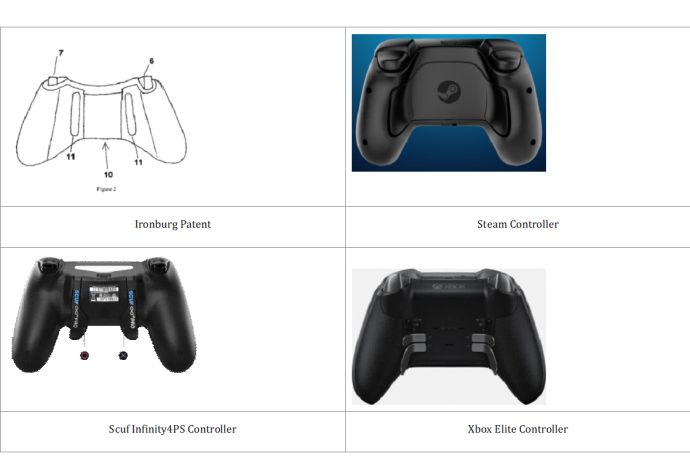In a case of British "David" v. US "Goliath", Ironburg v. Valve demonstrates the value for UK based companies to pursue a global patent strategy to protect their innovation overseas, particularly those in the gaming industry for which the US is a major market.
In 2015, Ironburg Inventions Ltd. (a UK company, and subsidiary of Corsair Gaming Inc.) filed a patent infringement case against Valve Corporation in respect of Ironburg's patent US 8,641,525 B2. Six years on and a jury has now found Valve guilty of infringement, awarding damages to Ironburg to the tune of USD 4 million. Not only was the patent infringed, but Valve were found guilty of wilful infringement, meaning that Ironburg can now apply for enhanced damages up to triple the initial award.
While we wait to see whether Ironburg will indeed apply for enhanced damages, Ironburg v. Valve already provides a good case study of US infringement proceedings with some useful takeaways for those in the UK seeking patent protection in the US.
Background
Ironburg's '525 patent is directed toward the presence of backpaddles on gaming controllers, which are switches provided on the underside of a controller in addition to the usual thumb sticks/buttons and rear triggers. These switches are commonly found on controllers made by Scuf, and the Xbox elite controller made by Microsoft, both of whom licence their technology from Ironburg. Valve developed their own controller using similar back paddles, but without seeking a license.

Of the defences presented by Valve to contest the alleged infringement, three in particular are interesting from a non-US perspective: (i) patent invalidity based on newly-found prior art after a pre-trial inter partes review; (ii) patent invalidity due to inequitable conduct; and (iii) patent invalidity due to indefinite claim construction.
(i) Considering patentability after Inter Partes Review – IPR Estoppel
Prior to trial, Valve initiated Inter Partes Review (IPR) against the '525 patent. In the US, IPR, which is conducted by the USPTO Patent Trial and Appeal Board (PTAB), is the process by which the validity of a granted patent may be put at issue. Those familiar with patent litigation will recognise this as a pretty standard opener by Valve as an alleged infringer: an attempt to have the patent revoked so that there is no case to answer to in the first place.
Importantly, the PTAB decided that at least some of the 525 claims were valid. For those interested, the claims which survived the IPR were 2-5, 7-12, 15 and 18.
At trial, Valve once again alleged that the claims that survived the IPR were invalid. Ironburg rebutted that Valve should be barred from pursuing such an invalidity claim further on the basis of IPR estoppel. IPR estoppel prevents a party from raising issues of validity again at a later time, where those issues were argued in the previous petition.
Crucially, Valve cited new prior art that was not previously considered by the PTAB. The Court therefore had to decide whether IPR estoppel applied to non-petitioned grounds; that is, grounds of invalidity which were not raised during the IPR.
A key feature of IPR estoppel is that it applies to any invalidity ground that the petitioner 'reasonably could have raised' during the IPR; it does not apply only to those matters which were actually raised during the IPR. US case law1 provides that grounds that could reasonably have been raised include those based on any patent or printed publication about which a petitioner actually knew or that "a skilled searcher conducting a diligent search reasonably could have been expected to discover".
In this case, the Court ruled that the new prior art cited by Valve could have been found by a diligent searcher at the time Valve filed its IPR petition. This was based, in part, on the fact that an IPR petition raised by another company found the same prior art. Thus, Valve were estopped from raising validity of the 525 patent in the court proceedings.
(ii) Inequitable Conduct
Valve further asserted that the '525 patent was invalid because Ironburg failed to fulfil their duty of candour to the USPTO. Those familiar with US patent prosecution will know that applicants for US patents have a duty of candour to disclose any and all prior art which they believe is materially relevant to the claimed invention.
A charge of inequitable conduct is not something to be taken lightly. The US federal circuit has described inequitable conduct, which renders the entire patent unenforceable, as the 'atomic bomb' of US patent law. A party which is found guilty of inequitable conduct often has that taint spread to other related patents and applications, thereby endangering that party's entire portfolio, and can leave the party vulnerable to antitrust and unfair competition claims, as well as open to allegations of fraud. There is no remedy available to an applicant if they are found not to have fulfilled their duty of candour.
Appropriately, the US courts apply a very high standard of proof to charges of inequitable conduct. The accused infringer must show by clear and convincing evidence that the patentee misrepresented or omitted material information with specific intent to deceive the USPTO. Even if this burden is met, the court then weighs whether a finding of inequitable conduct would be equitable in the given case. In the present case, Valve's accusation did not meet the standards required.
With regards to omitting material information, the US courts apply the 'but for' test: would the patent have been found invalid 'but for' the fact that material information was withheld from the USPTO. That is, the court evaluates whether the patentee's behaviour in withholding any such material information resulted in the unfair benefit of receiving an unwarranted claim. In particular, if the patent would have issued anyway, the applicant has obtained no advantage from the omission.
In the present case, the Court found that the allegedly omitted prior art did not have any material effect on the claims. Indeed, the same prior art had been dismissed as irrelevant by the PTAB.
With regard to intent to deceive, the Court found that Valve also did not show the requisite standard of proof. While Ironburg was aware of the particular cited reference, it transpired that Ironburg had instructed the prior art to be disclosed but a mistake by one of their attorneys resulted in it being missed from the information disclosure statement. Moreover, the mistake was eventually noticed and a subsequent IDS filed containing the reference.
With these two points concluded the Court did not need to decide on the third aspect of whether it would be equitable to impose such a judgment on Ironburg.
(iii) Indefinite claims – Use of 'substantially'
The defence proffered by Valve here was that the '525 patent claims are invalid because the scope is impossible to determine due to the use of indefinite terminology. One such term in particular stands out due to contrasting practice on this side of the Atlantic, particularly regarding the European Patent Office: "substantially".
The presiding US case law states that a patent is presumed valid unless the "claims, read in light of the specification delineating the patent, and the prosecution history, fail to inform, with reasonable certainty, those skilled in the art about the scope of the invention"2, and that "claim language employing terms of degree may be found definite where it provides enough certainty to one of skill in the art when read in the context of the invention"3.
The claim at issue includes the line that elongate members extend "substantially the full distance between the top edge and the bottom edge" of the outer case of the handheld controller. During the PTAB, the phrase was construed as meaning that the elongate members extend "largely but not necessarily the entire distance between the top and bottom edges" of the controller.
Valve alleged that the expression substantially (largely, as construed) is vague and fails to advise a person of ordinary skill in the art how long the elongate members must be. The Court disagreed, finding that the word substantially is a term of approximation generally understood to indicate largely but not wholly that which is specified. The Court determined that the purpose of the elongate shape of the paddles is to allow a user to engage the paddles with any one of the middle, ring or little finger, and that as such, the claim terminology of "substantially the full distance" between the top and bottom edges of the controller could be readily understood by the skilled artisan to be varied to the average span of a human hand.
Commentary
So what we can learn from Ironburg v Valve on this side of the pond?
First, Inter Partes Review must be done diligently.
It is highly likely there will be only one chance at revoking a competitor's patent, so it needs to be done right. All grounds that could be conceived of, and all the relevant prior art, need to be raised at the first instance.
In this internet age, the ease with in which a 'skilled searcher' can now discover information means that the bar is now very high to show that, to the contrary, a skilled searcher would not have found a particular piece of prior art that is now being relied on in a subsequent invalidity attack. Therefore, performing comprehensive searches, maintaining good records of how those searches were performed and the results they yielded should become, if not already, standard practice. Then, if new prior art is found later, at least there is some evidence to show why it was not found previously.
Second, a charge of inequitable conduct could be catastrophic.
The consequences for being found guilty puts not only the patent in suit at risk, but an entire portfolio, and can expose the proprietor to further lawsuits. It is therefore imperative for applicants to treat the duty of candour with the USPTO seriously, lest they leave themselves open to such an attack by a competitor (or even the USPTO itself). The term "material information", and the associated test, suggests that only prior art which would limit the scope of protection of the claims needs to be disclosed, and certainly this is a good starting point. However, to borrow some phrases from European practice, it would seem prudent to disclose known prior art which is in the 'same field' and directed toward the 'same purpose', just to ensure all bases are covered.
The best advice for applicants is to share any prior art you are aware of which may be relevant to your invention with your attorney and ask for advice.
Third, a reminder to my UK and European colleagues preparing applications for the US, that our American cousins allow for a great deal more vagueness in the scope of the claims than we are used to in our day to day practice.
That said, vague wording can still get one into trouble if it is found that claim language is indefinite, and so care must still be taken when preparing a patent application with global intent.
Finally, is there anything the UK game industry can learn from Ironburg v Valve? Emphatically yes!
While the key decisions of this case apply to anyone pursuing US patent protection, the case in general shows that there is relevance to gaming companies in the UK pursuing an IP strategy which includes at least the US. The games industry is a truly global, cross-border, industry, and the US is home to many of its biggest players. Being able to licence technology, as well as having the option to litigate in these players' home territory is highly advantageous and potentially very valuable (as demonstrated by Ironburg).
Footnotes
1 particularly from Cyonix and Milwaukee Elec
2 Nautilus Inc. v. BiosigInstruments, Inc
3 Biosig Instruments, Inc. v. Nautilus, Inc
The content of this article is intended to provide a general guide to the subject matter. Specialist advice should be sought about your specific circumstances.
